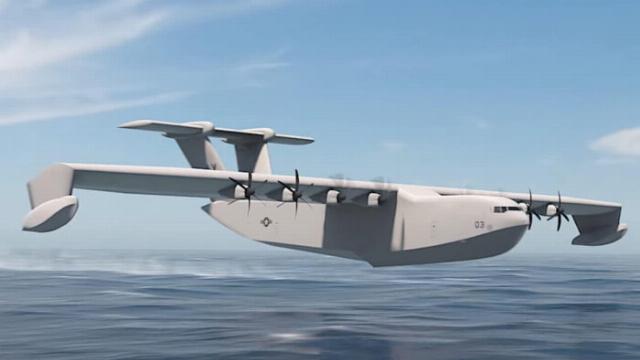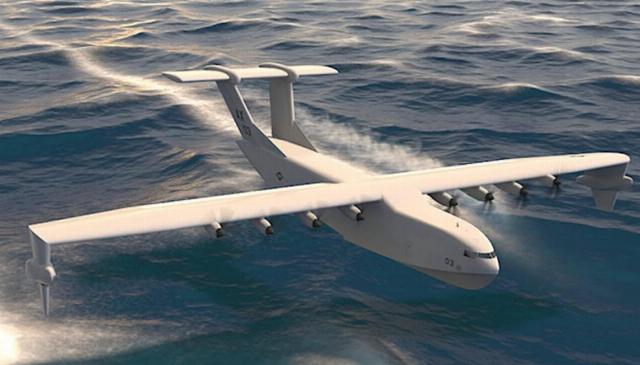Boeing's aviation and aeronautics research subsidiary Aurora Flight Sciences has provided new details about the design of a demonstrator it is working on for the Liberty Lifter program of the U.S. Department of Defense Advanced Research Projects Administration (DARPA). The main goal of Liberty Lifter is to demonstrate a new ekranoplane design using the principle of increasing lift due to proximity to the surface ("wing-in-ground", WIG). A future aircraft based on the demonstrator could provide the U.S. Armed Forces with a new way to transport large amounts of cargo and personnel over long distances at low cost without the need for traditional runways.
As it became known, in 2023 Aurora Flight Sciences and General Atomics received contracts to carry out initial work on the Liberty Lifter. A year later, DARPA selected Aurora Flight Sciences to continue the independent development of the flying demonstrator.
The latest Aurora Liberty Lifter concept art depicts a flying boat with a V-shaped fuselage and a large straight wing with floats on the tips, powered by eight turboprop engines located on the wing. It also has two vertical tail fins connected at the top by a horizontal stabilizer. Cargo, including light armored amphibians, is unloaded via a large rear ramp. The General Atomics concept had a more radical design with two fuselages.

The ekranoplane project from Aurora Flight Sciences
According to a source at Aurora, the demonstration sample is approximately 80% consistent with the target aircraft. We are talking about a promising aircraft with a payload capacity close to the C-130 Hercules, 25 tons of payload. The wingspan of the demonstrator is expected to be about 66 m. It is planned that it will be equipped with engines supplied by the US government.

Military transport aircraft C-130 (in the foreground) and C-17A
DARPA previously stated that the ultimate goal of the Liberty Lifter project is to develop a design with a payload comparable to the C-17A Globemaster III cargo aircraft. The stated maximum payload weight of the C-17 is about 82 tons, although aircraft usually fly with cargo and personnel on board weighing about 60 tons or less.
The requirements for the Liberty Lifter, which DARPA had previously publicly published, also include the ability to take off and land in open water with sea waves up to 4 points and "stable operation on water" with sea waves up to 5 points. These two sea states are characterized by wind speeds from 5.5 to 7.9 m/s and from 8 to 10.7 m/s, as well as wave heights from 0.9 to 1.5 m and from 1.8 to 2.4 m, respectively.

Unloading equipment from the Liberty Lifter ekranoplane
The idea of a flying platform using the WIG principle is not new, but historically such designs have not been very successful, especially in the military field. The Soviet Union remains the most famous operator of WIG military structures, also known as ekranoplanes.
In principle, ekranoplanes are highly efficient surface vessels that can move at high speed, since they do not experience the resistance typical of conventional vessels, and also receive lift from the wing. At the same time, high-speed flight over the sea surface is fraught with difficulties, including the risk of collision with various objects on the surface or even just with high wave crests.
To help circumvent these problems, the DARPA Liberty Lifter program has called for the creation of something like a hybrid design that, if necessary, is still capable of operating like a traditional flying boat at "altitudes up to 3,000 m above sea level with reduced range."
DARPA is expected to make a decision on whether to proceed to the next stage of development of the Liberty Lifter in the summer of 2025. The construction site of the final product remains open. One of the objectives of the program is to study the production processes of marine vessels, not just aircraft. Thus, the aircraft will be created using a combination of shipbuilding and aircraft manufacturing processes. In this regard, it is noted that from the very beginning, Gibbs & Cox, a company engaged in naval architecture and marine construction, participated in the Aurora project.
The Liberty Lifter program is also currently developing, building, testing, and commissioning an affordable, innovative seaplane that is claimed to have the potential to transform the approach to rapid logistics for the Department of Defense and commercial organizations. The program can also provide search and rescue operations at sea and ship-scale disaster response at the speed of air transport.
According to DARPA, the Liberty Lifter can become not only an alternative to traditional cargo planes, but also a new tool for "efficient transportation of large loads at speeds significantly exceeding existing offshore lifting platforms." It is believed that maritime logistics capabilities, which are faster than existing cargo ships and do not rely on runways like many traditional transport aircraft, could be especially valuable in a future conflict in the Pacific.
In addition, the Liberty Lifter is expected to avoid many maritime threats such as submarines and anti-ship missiles. Flying at very low altitude usually increases overall survival by helping to hide the aircraft from protective equipment, especially their radars.
It is still unclear whether DARPA will decide to continue working on the Liberty Lifter and when the planned Aurora demo will be able to take to the air for the first time. The program is currently considering the possibility of starting flight tests in 2028-2029, which is a one-year delay from the original schedule. At the moment, the Aurora project is taking shape.
According to the material twz.com

